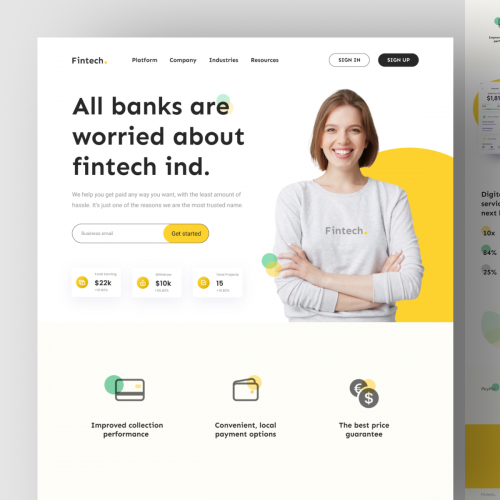Multi-Device Website Design for Seamless Viewing on Any Device
Multi-Device Website Design for Seamless Viewing on Any Device
Blog Article
Top Tips for Developing an Impactful Website Layout That Transforms
To attain this, one need to take into consideration a variety of elements, consisting of comprehending the target audience, prioritizing customer experience, and maximizing for mobile platforms. The critical use of compelling call-to-actions and a distinct visual power structure plays a vital function in guiding customers through their trip.

Understand Your Target Market
Comprehending your target market is fundamental to effective internet site layout, as it lays the groundwork for producing an appealing customer experience. Recognizing that your customers are, including their demographics, choices, and habits, makes it possible for designers to customize the web site's material, format, and performance to meet details demands.
Conducting complete market study is vital in this procedure. Studies, meetings, and analytics can give beneficial insights into individual assumptions and discomfort points. By compiling this data, developers can create user characters that stand for various sectors of the audience, ensuring that style choices are educated and pertinent.
Moreover, comprehending the target market aids in choosing suitable style aspects such as shade systems, typography, and imagery that resonate with customers. A web site that talks directly to its audience cultivates a feeling of connection and trust fund, motivating longer brows through and higher conversion prices.
Inevitably, a user-centered approach to site layout not just enhances individual fulfillment however also sustains organization goals by driving interaction and commitment. By prioritizing the requirements and choices of the target market, an internet site can efficiently serve its objective and accomplish preferred results.
Prioritize User Experience
To boost the overall efficiency of a website, focusing on customer experience (UX) is vital (Website Design). A well-designed UX guarantees that visitors can navigate the website easily, discover details swiftly, and engage with material meaningfully. This results in increased individual contentment and greater conversion rates
Begin by executing instinctive navigating. Menus must be rationally structured, enabling individuals to locate essential areas of the site with minimal effort. Uniformity in style elements, such as color systems and typefaces, cultivates knowledge, which is vital for preserving customer involvement.
Furthermore, consider the loading speed of your site. A hold-up of simply a couple of seconds can bring about substantial drop-offs, as customers are much less likely to await a slow-loading web page. Improving photos and maximizing code can boost performance and retain site visitors.
By focusing on user experience, you not just create a more enjoyable setting for site visitors however likewise enhance your brand name's reputation. Inevitably, an emphasis on UX is a financial investment in the long-term success of your site.
Optimize for Mobile Instruments
Enhancing for mobile gadgets is vital in today's electronic landscape, where a raising variety of customers accessibility websites with smartphones and tablets. A mobile-friendly style not just improves individual experience but likewise plays a substantial duty in improving online search engine rankings. To attain this, it is important to adopt a responsive style that instantly gets used to various display sizes and positionings.

Packing speed is one more crucial element; mobile customers are generally much less patient and anticipate rapid accessibility to info. Optimize photos and leverage web browser caching to boost performance. Examination your click this site website on multiple tools and display resolutions to recognize and remedy any prospective functionality concerns. By prioritizing mobile optimization, you make certain that your web site remains affordable and efficiently engages a wider audience.
Usage Compelling Call-to-Actions
An internet site's efficiency often rests on its ability to direct visitors toward wanted activities, making engaging call-to-actions (CTAs) necessary elements of layout. CTAs function as the pivotal points that guide individuals to engage with the site, whether that means buying, signing up for an e-newsletter, or downloading a resource.
To create reliable CTAs, quality is paramount. Use concise language that plainly communicates the action you want the customer to take. Expressions such as "Obtain Started," "Sign Up Free," or "Store Now" not just share necessity however likewise get rid of obscurity. The positioning of CTAs is similarly vital; they need to be purposefully placed throughout the webpage to guarantee they are conveniently visible, particularly in high-traffic areas.
In addition, the style of CTAs ought to stand out without being obtrusive. Use contrasting colors and clear fonts to ensure they record attention. Additionally, consider making use of directional hints, such as arrows or pictures, to lead individuals toward these buttons. By concentrating on these elements, organizations can dramatically improve customer interaction, driving conversions and eventually accomplishing like this their website's goals.
Focus on Visual Pecking Order
Reliable website design counts heavily on a well-structured aesthetic hierarchy that overviews individuals through material seamlessly. By arranging aspects in a manner that prioritizes info, designers can boost customer experience and promote decision-making. This entails using dimension, shade, comparison, and spacing tactically to accentuate the most essential components of a page.
Making use of larger fonts for headings and subheadings develops a clear distinction in between different areas, enabling customers to scan content effortlessly. Additionally, using contrasting colors for switches and calls-to-action can catch customer attention and motivate communication. Whitespace is one more important part; it stops clutter and allows users to focus on key messages without distractions.
Pictures and graphics need to match the text while also sticking to the well-known hierarchy, enhancing the overall message (Website Design). Uniformity in style elements, such as color design and typography, additional reinforces the visual power structure, making navigation user-friendly

Final Thought
In conclusion, effective site layout demands a detailed understanding of the target audience, prioritization of user experience, and mobile optimization. Eventually, a well-executed site design offers as a critical component in driving user activities and achieving organization purposes.
Report this page